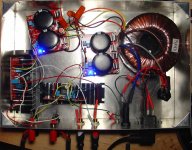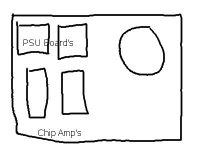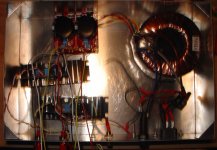So the good news is my BrianGT dual-mono gainclone is making music. The bad news is, she is also humming a bit. The interesting part is that there is a lot more buzz in one channel than the other.
All parts including the toroid are in one chassis. Input is a dirt-cheap CD player but the hum comes when nothing is connected so I don't think that's the culprit (though I can for the first time hear how bad it is). No volume control at this time--was going to build a preamp/buffer to go with it.
Grounds from the amp boards are all tied to a central point on the chassis ground which is tied to safety earth.
The wiring inside is admittedly a bit of a dog's breakfast. The chassis is a bit tighter than I expected and I decided to "just get it running" first and then clean it up. As a result the power off the rectifier boards and the signal lines cross around each other a bit here and there. I will post a picture later for everyone to laugh at.
One thing I noticed right off the bat was that the DC offset was different on the two channels- ~95Mv on one and ~65Mv on the other. The buzzy one has the lower offset.
When I first assembled it, I put only one channel together to make sure before blowing anything up. That channel (the 95Mv one) had a little hum, but it was the second one where it got a bit louder.
I don't have a lot of room, but by pushing things around inside I can get the hum to change a little. I pushed a little too hard and made some sparks between power and chassis, but the guardian angels took pity and did not seem to allow anything to fry. I don't expect to get lucky again.
Is there anything in the offset differential between the two channels that points in any particular direction? I'm ready to re-do the chassis in a larger box for other reasons, but I wouldn't mind fixing this one first just for the educational value.
Oh, and this is hooked up to a pair of freshly-made One Pi speakers (8 ohm). Hum aside, the whole setup is still listenable at normal volume and very pleasantly surprising. I have friends with very good and expensive systems, and this ~$400 setup really gives some of the same sensations for 5% of the price. If I can get the hum out it will be a real beauty.
All parts including the toroid are in one chassis. Input is a dirt-cheap CD player but the hum comes when nothing is connected so I don't think that's the culprit (though I can for the first time hear how bad it is). No volume control at this time--was going to build a preamp/buffer to go with it.
Grounds from the amp boards are all tied to a central point on the chassis ground which is tied to safety earth.
The wiring inside is admittedly a bit of a dog's breakfast. The chassis is a bit tighter than I expected and I decided to "just get it running" first and then clean it up. As a result the power off the rectifier boards and the signal lines cross around each other a bit here and there. I will post a picture later for everyone to laugh at.
One thing I noticed right off the bat was that the DC offset was different on the two channels- ~95Mv on one and ~65Mv on the other. The buzzy one has the lower offset.
When I first assembled it, I put only one channel together to make sure before blowing anything up. That channel (the 95Mv one) had a little hum, but it was the second one where it got a bit louder.
I don't have a lot of room, but by pushing things around inside I can get the hum to change a little. I pushed a little too hard and made some sparks between power and chassis, but the guardian angels took pity and did not seem to allow anything to fry. I don't expect to get lucky again.
Is there anything in the offset differential between the two channels that points in any particular direction? I'm ready to re-do the chassis in a larger box for other reasons, but I wouldn't mind fixing this one first just for the educational value.
Oh, and this is hooked up to a pair of freshly-made One Pi speakers (8 ohm). Hum aside, the whole setup is still listenable at normal volume and very pleasantly surprising. I have friends with very good and expensive systems, and this ~$400 setup really gives some of the same sensations for 5% of the price. If I can get the hum out it will be a real beauty.
Hey dude, havent given up on ya yet...
Those Offset voltages are on the high side, and how hot are the chips getting, as I suspect that we have some parasitic oscillation going on.
Could you post some pictures of your set-up in the gainclone, so we can see what's going on..?
Thanks
Owen
PS - could you turn on the function to accept email from board members - I need to send you some details so that we can get you pre-amp working!
Those Offset voltages are on the high side, and how hot are the chips getting, as I suspect that we have some parasitic oscillation going on.
Could you post some pictures of your set-up in the gainclone, so we can see what's going on..?
Thanks
Owen
PS - could you turn on the function to accept email from board members - I need to send you some details so that we can get you pre-amp working!
OK, and here comes the ugly duckling... I tried to use wire colors as consistently as possible:
Green: Safety earth (star is in the lower RH corner area)
White: PG- or Signal Ground (L and R)
Black: V-
Yellow: PG+ or L In
Red: V+ or R In
Heat sinks are TO3 with fins hacksawed off. Chips are insulated variety, and I haven't cranked it, but the heatsinks get slightly warm, but not hot, subjectively speaking...
Leads are a mess, I know- I left them a little long at first so I'd have some slack to work with to figure out the chassis layout. Nothing has been screwed down yet. The case is 12" wide and I think I may go back to the shop and get the 15" or 17" one and then I can group things around better, but if I can make this chassis work well I'd be happy with it.
Green: Safety earth (star is in the lower RH corner area)
White: PG- or Signal Ground (L and R)
Black: V-
Yellow: PG+ or L In
Red: V+ or R In
Heat sinks are TO3 with fins hacksawed off. Chips are insulated variety, and I haven't cranked it, but the heatsinks get slightly warm, but not hot, subjectively speaking...
Leads are a mess, I know- I left them a little long at first so I'd have some slack to work with to figure out the chassis layout. Nothing has been screwed down yet. The case is 12" wide and I think I may go back to the shop and get the 15" or 17" one and then I can group things around better, but if I can make this chassis work well I'd be happy with it.
Attachments
First things first.
You should twist the input cables together for each channel (i.e. hot and ground for left channel twist together), and do likewise for the output cables.
This will clear the field of view.
You also have a ground running from the PCB to the inputs, and from the PCB to a central ground point, and grounds from the PSU PCB to your gainclone PCB. This should all be conneected to a single point per channel, and that ground reference taken to a star ground using a bypassed 100R resistor (take a look at the schematic at decibel dungeon), to connect to the chassis ground.
These two measures alone will significantly reduce the opportunity for induced hum in your amp, and will be a good place to start.
Ok?
Owen
Ps. you can email me at owenanti423spam at netscape dot net (remove the anti, the spam, replace the at with @, and the dot with .). I'd like to get your preamp sorted
You should twist the input cables together for each channel (i.e. hot and ground for left channel twist together), and do likewise for the output cables.
This will clear the field of view.
You also have a ground running from the PCB to the inputs, and from the PCB to a central ground point, and grounds from the PSU PCB to your gainclone PCB. This should all be conneected to a single point per channel, and that ground reference taken to a star ground using a bypassed 100R resistor (take a look at the schematic at decibel dungeon), to connect to the chassis ground.
These two measures alone will significantly reduce the opportunity for induced hum in your amp, and will be a good place to start.
Ok?
Owen
Ps. you can email me at owenanti423spam at netscape dot net (remove the anti, the spam, replace the at with @, and the dot with .). I'd like to get your preamp sorted
Banned
Joined 2002
I would also like to add. See if you can remove the psu boards away from the transformer those are really close. Try organizing the inside of the case so you can have the transformer away from every thing if possible. Maybe get some copper shield. Do twist the wires like owen said. The wire you have is good but twisting it will help alot. If stil huming let us know we are all here to help you.
J'
J'
Owen, I will try those suggestions. Will need to review the DecDun site a bit more but I think I have the idea.
As you can see, the case is a little bit tight, so we're talking tradeoffs here. In order to move things away from the toroid, I'll need to move the amp boards and rectifiers closer to each other.
If I get a larger chassis, is there any ideal spacing guideline to work around? Where is the tradeoff between more air gap versus lead length?
As you can see, the case is a little bit tight, so we're talking tradeoffs here. In order to move things away from the toroid, I'll need to move the amp boards and rectifiers closer to each other.
If I get a larger chassis, is there any ideal spacing guideline to work around? Where is the tradeoff between more air gap versus lead length?
Banned
Joined 2002
sansbury said:Owen, I will try those suggestions. Will need to review the DecDun site a bit more but I think I have the idea.
As you can see, the case is a little bit tight, so we're talking tradeoffs here. In order to move things away from the toroid, I'll need to move the amp boards and rectifiers closer to each other.
If I get a larger chassis, is there any ideal spacing guideline to work around? Where is the tradeoff between more air gap versus lead length?
From your picture you could move the amp's on heat sinks in parallel and then move the psu boards side by side. That will work. YOu could also see if you can get a 5"-6" piece of copper tube about 2.5" and put it around the transformer. Maybe a piece of Steel tube..
Id try twisting the wires But also connect one amp at a time see if it still hums.. Try moving the stuff around in the box when amp is on with no signal..
Have you tried to short the positive pin of the input jack to ground ? does the hum stop ?
J'
Banned
Joined 2002
Hey Sansbury, I posted this link in your other thread, it might be relevant to your problem:
http://www.diyaudio.com/forums/showthread.php?s=&threadid=95451
Ian
http://www.diyaudio.com/forums/showthread.php?s=&threadid=95451
Ian
Ian- Thanks for the link. I read through, and saw lots of interesting stuff. What did you actually end up doing? I saw four things:
1) Two transformers
2) Peter Daniel's interconnected rectifiers approach (if I'm interpreting his approach properly)
3) Disconnecting network on safety earth
4) All of the above
Truth be told, it wouldn't kill me to just use one rectifier board for now, and build a "true monoblocks" approach later with two toroids when I feel like it, if that will give good results.
1) Two transformers
2) Peter Daniel's interconnected rectifiers approach (if I'm interpreting his approach properly)
3) Disconnecting network on safety earth
4) All of the above
Truth be told, it wouldn't kill me to just use one rectifier board for now, and build a "true monoblocks" approach later with two toroids when I feel like it, if that will give good results.
I am currently running a single rectifier board and I have the second transformer waiting to be installed. I would have done it by now, but it means altering the layout of the inside of the amp case and some rewiring.
I haven't done the disconnecting network yet, but i need to as the pops are driving me nuts!
I haven't done the disconnecting network yet, but i need to as the pops are driving me nuts!

am currently running a single rectifier board and I have the second transformer waiting to be installed. I would have done it by now, but it means altering the layout of the inside of the amp case and some rewiring.
How will you wire this configuration(two trannies, two rect supplies and four ampboards) as that it what I want to do?
How does a person make a "disconnecting network "? and also apply this to the above?
There comes a time when a man must make the fateful choice- to strip, or not to strip, that is the question. So I stripped things down and have decided to try reconfiguring the amp in a stereo mode first, and then decide where to go from there.
Here's roughly what I'm thinking. I realize there are potentially better ways to lay this out but I think that's going to wait for Rev 3. After all, if I do this one too well, then what will I have to build next?
Here's roughly what I'm thinking. I realize there are potentially better ways to lay this out but I think that's going to wait for Rev 3. After all, if I do this one too well, then what will I have to build next?
Attachments
DeanP said:
How will you wire this configuration(two trannies, two rect supplies and four ampboards) as that it what I want to do?
How does a person make a "disconnecting network "? and also apply this to the above?
Nope, 2 transformers, 2 rectifier boards and 2 amp boards... true mono all the way.
There is some information on the thread I posted about disconnecting networks, which basically make connecting the amp ground to the safety earth a bit less problematic.
Mayday said:Can't be lazy when it comes to DIY
Tis true, but I have had lots of other things to do. I'll get onto asap though now you have publicly embarrassed me!!
- Status
- This old topic is closed. If you want to reopen this topic, contact a moderator using the "Report Post" button.
- Home
- Amplifiers
- Chip Amps
- Let there be music :) ...and Hum :(



